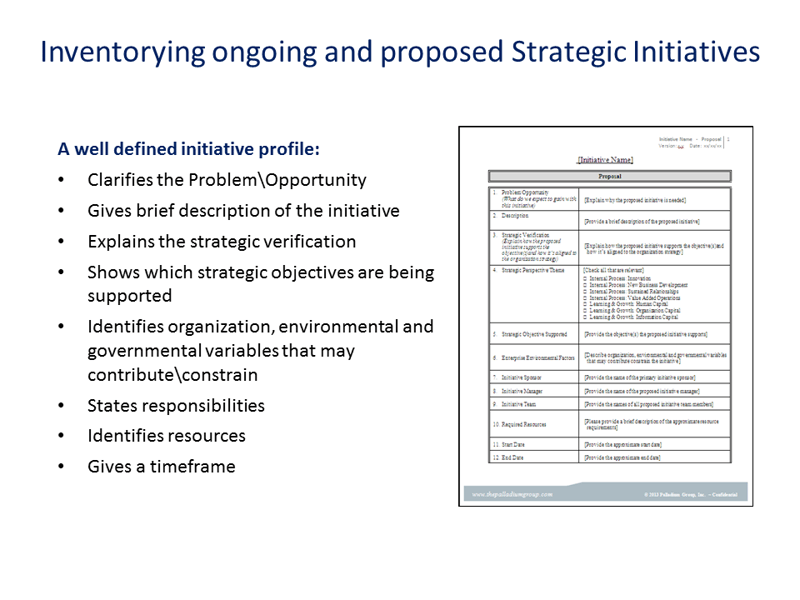What is a Strategic Initiative?
A definitive balanced scorecard guide to strategic initiatives.
Strategic Initiatives Close the gap between current and desired performance levels
Once Balanced Scorecard Objectives and Measures are in place, the strategic planning team must choose how to finally accomplish the goals that have been laid out. As we have covered in our blogs before, the Initiatives are the BSC component focused most clearly on execution. This is where the rubber hits the road! Initiative planning is usually started after measures are determined, and it can offer a nice break after the mental exhaustion caused by picking KPIs.
Whether this is your first Initiative creation process or this is your 15th refresh, check out this six-step best practice process for streamlined Initiative creation.
- Inventory – Identify all existing Initiatives
- Propose - Brainstorm new Initiatives
- Align – Theorize a relationship between Initiatives and Objectives
- Refine – Identify gaps in alignment and adjust priorities accordingly
- Define - Complete Initiative Profiles
- Prioritize – Choose which Initiatives to fund and when
Depending on the amount of pre-work completed by the strategic planning team and the amount of homework done by members of the leadership team, each of these steps may require somewhere between 30 minutes and two hours. Plan accordingly, as Initiatives offer some of the more interesting conversation-starters for your team. Initiatives represent the key variable of the Balanced Scorecard’s cause-and-effect relationships, and they often reveal key disagreements around how the organization will accomplish its goals. To get started, first the team will need to figure out what Initiatives are currently ongoing.
1. Inventory – Identify all existing Initiatives
For some organizations, the definitional lines between “projects,” “Initiatives,” and “tasks” become blurred, which complicates the first step of the process.
After clear organization definitions have been set, the strategic planning team will need to lay out each ongoing Initiative. Commonly, part of the exercise may be kicked off in advance by one or two facilitators to provide the team with a template, reduce time spent on common knowledge, and generate conversation from a strawman.
Strategy leaders who facilitate these conversations will also require a platform to quickly capture notes and alignment. In the initial inventory and propose phases, utilize an Excel template to track your ideas. Excel can ultimately save time later as facilitators may want to use the same spreadsheet to capture objective-Initiative alignment. (By the way, ESM creates templates, captures notes, and tracks alignment automatically if you’d like to save a couple of hours pulling your hair out fighting an Excel spreadsheet).
It is especially important in the Initiative inventory phase to carefully discriminate between operational and strategic Initiatives. Remember – a strategic Initiative will have start/end dates to signal a scoped investment or process change. Repeating this categorization early on is an opportunity for the facilitator to reinforce shared definitions and vocabulary.
Inventorying ongoing Initiatives is a relatively mechanical step in the planning process, as most organizations have a form of project management in place to keep track of investments. Initiatives may often already be articulated by an existing budget as well, providing an easy repository to pull ideas from. However, a common challenge with the inventory session is a high-volume of Initiatives. High Initiative volume may be a symptom of poor categorization of operational vs. strategic projects, a complex organizational plan, or overly ambitious leadership. Regardless of the reason, strategic planning teams often benefit from breaking big Initiative lists down thematically into strategic groups called portfolios. Portfolios help strategic planning teams to better understand where resources are invested through simple organizational groupings.
2. Propose - Brainstorm new Initiatives
Either as part of the inventory workshop or in an entirely separate session, the leadership team will next outline ideas for new Initiatives. The propose session is a great opportunity for risk-free brainstorming. Organizations often preach the importance of innovation without any concrete means to build on it. Strategic planning offers a system and forum for leaders to bring new ideas to the table.
Proposed Initiatives should be categorized, discussed, and worked down to a manageable list (no more than 25). Each proposed Initiative may not be enacted, but will prove useful as the team attempts to determine the relative value of each inventoried and proposed Initiative.
3. Align - Theorize a relationship between Initiatives and Objectives
Objective and Initiative alignment might be my favorite part of the whole strategic planning process. The alignment phase is when the full Balanced Scorecard comes together for the first time, and you can start to visualize how all the different pieces fit together.
The alignment phase is also the first time where you can clearly see and articulate gaps in the process. For example, do you have internal process Objectives that do not have any linked Initiatives? If so, why aren’t you investing in that particular Objective? Is the Objective in question truly a critical strategic Objective or is it just taking up space on your map?
The alignment activity itself is most easily completed in an Excel table with each Initiative in its own row on the left and each Objective assigned to a column along the top (In case you're looking for an easier, faster way, ESM does this automatically!)

As a team, link each Initiative to an Objective. If there is no logical connection between an Initiative and Objective, take note. You’ll want to keep those missing linkages in mind as you prioritize your various Initiatives.
A common mistake is to link Initiatives to a bunch of Objectives haphazardly. By linking Initiatives to multiple Objectives, you dilute the natural cause-and-effect relationships inherent to the Balanced Scorecard. Politics plays a role here as leadership try to hold up their pet project as the one Initiative to rule them all.
One technique is to pick an objective as the “primary objective” that an Initiative supports. This helps narrow down the relationships, but can still leave open the possibility of creating a messy web of interrelationships. As always, keep it simple. When possible, link an Initiative to just one objective. If an Initiative naturally links to more than one Objective, try to limit the linkages to two or three.
4. Refine – Identify gaps in alignment and adjust priorities accordingly
With alignment complete, the team may find that there are holes in the initial draft of the plan. Your team will want to look for:
- An Initiative that is not linked to any Objectives
- An Objective that lacks any Initiative support
- An Objective with too many Initiatives
Let’s put the first bullet aside for the moment, as we’ll review unlinked Initiatives in the prioritize phase. Any Objective that lacks Initiative support may indicate a couple of things. Perhaps the Objective is not a critical strategy for your organization? Some Objectives don’t get the love they deserve just due to the natural tension of limited time and money in any organization. When facilitating, I like to prod and ask to see if a client has overstated the necessity of a particular strategic Objective. Other times, the solution is to simply brainstorm an Initiative to support the Objective. A word of caution if you go the latter route – you actually need to execute whatever Initiative you think up, so in this phase it is important to temper the idealism of the brainstorm with a dose of pragmatism.
On the flip side, an Objective that has more than three or four Initiatives will be a useful place to look when making decisions around resourcing Initiatives. If one Objective has three or four supporting Initiatives, and another process Objective has none, it may be prudent to reallocate resources to adjust.
5. Define – Complete Initiative Profiles
Now that the team has a list of all inventoried and brainstormed Initiatives with proposed Objective linkages, the next step is to clearly scope out each project. This should include owners, start/end dates, deliverables, and milestones/tasks. For more information on what characterizes an effective Initiative, check out our blog post here.
Much of the define step can be completed offline. It is possible to structure the first four steps as one big session, then assign the define step as homework. Regardless of how you choose to complete the Initiative definitional profiles, this step is critical so that when you have Initiative prioritization discussions, everyone has a shared understanding of the Initiative’s scope and intent.

6. Prioritize - Choose which Initiatives to fund and when
The final step of the Initiative creation process is to select the Initiatives that are vital to your strategy, determine when each will start, and allocate budgets. There are a number of ways to go about the Initiative Prioritization process, and I will only touch on a couple of them here. The goal of the prioritization activity is to force the strategy team to look at available resources and choose which Initiatives will receive short and long term investment.
One approach to get a general sense of the leadership team’s priorities is to start with a simple voting exercise. Each team member will secretly write down their top three Initiatives and one they would remove. The initial vote identifies low hanging fruit that the team can easily add or remove.
A slightly more scientific approach to the voting may be necessary as well. A common solution is to use a scoring sheet with positive and negative criteria that are assessed for each Initiative. Each positive and negative score can be weighted in a final calculation that provides every Initiative with single prioritization score.

Scoring is not a silver bullet. It will, however, provide the team with a common framework to go about the voting process.
Even though this is a team activity, executive decisions are required for all final Initiatives. This is an excellent opportunity for the chief executive to fully imprint their vision of the execution of the strategic plan.
Summary and Next Steps
So now that you’ve got a list of Initiatives, you’re done right? Alas, the pesky steps of actually implementing the Initiative plan remains. Most organizations stop right here. After months of strategic planning, the follow-through on the plan fails.
If you do not currently have an Initiative review component of your strategy management system in place, I encourage you to consider installing a regular meeting to discuss the progress of one-two Initiatives in addition to regular Strategy Review Meetings. Maintaining discipline of a review process dramatically drives commitment to your plan, forces the team to reconcile missed deadlines, and allows for corrections of incorrect assumptions made in the initial planning process.







